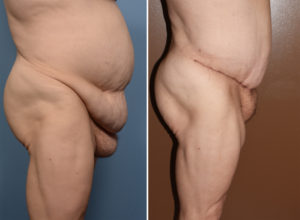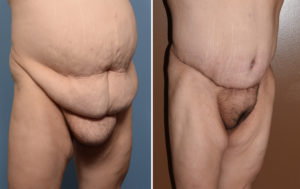Background: Large amounts of weight loss cause an expected amount of abdominal skin looseness and overhang. The deflation of the abdominal and waistline fat causes a resultant skin excess that hands down. This most commonly results in a single roll of tissue that hangs over the waistline known as an abdominal pannus. In patients with a lot of remaining intra-addominal fat or a thick upper abdominal subcutaneous fat layer, the deletion of weight loss causes a tissue roll above the umbilicus as well as below it. (double roll abdominal deformity)
But a third roll in weight loss patients is also possible but it does not involve the abdomen per se. If one has a large pubic region initially it will partially deflate and sag. This smaller tissue roll is pushed down by the larger tissue roll above it, creating the third roll or the triple roll abdominal deformity.
A large and low hanging pubic ‘pannus’ complicates the tummy tuck design for these larger excisional patients. Should the central part of the lower tummy tuck incision go lower to remove the upper third of the sagging pubic mound or should the tummy tuck markings be done in the standard fashion above the pubic mound and just do liposuction of the pubic mound to further deflate it? Or should some combination of both pubic mound management strategies be done?
Case Study: This 45 year-old female lost over 60lbs on her own but developed the triple roll abdominal deformity. She has a large and full pubic mound that hung down between her inner thighs.


The triple roll abdominal deformity is a difficult problem to ideally correct in a one-stage procedure. It often takes a second procedure to improve the results of the first tummy tuck with additional fat and skin removal.
Highlights:
1) The ‘triple roll’ abdominal deformity can happen after a lot of weight loss in certain women.
2) The third roll in this type of abdominal lipodystrophy is the pubic ‘pannus’.
3) The low hanging and full pubic pannus must be factored into the design of the tummy tuck.
Dr. Barry Eppley
Indianapolis, Indiana



